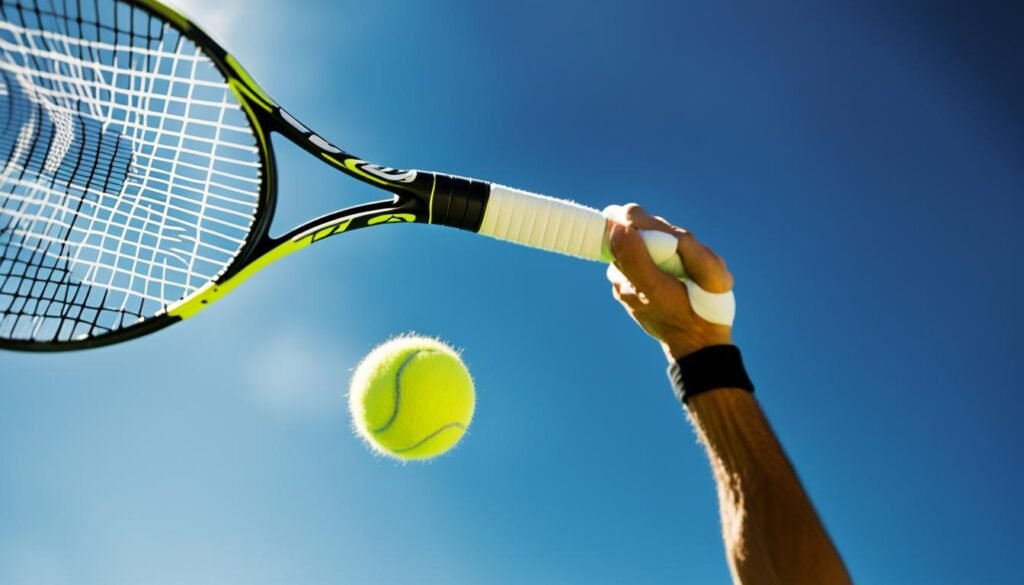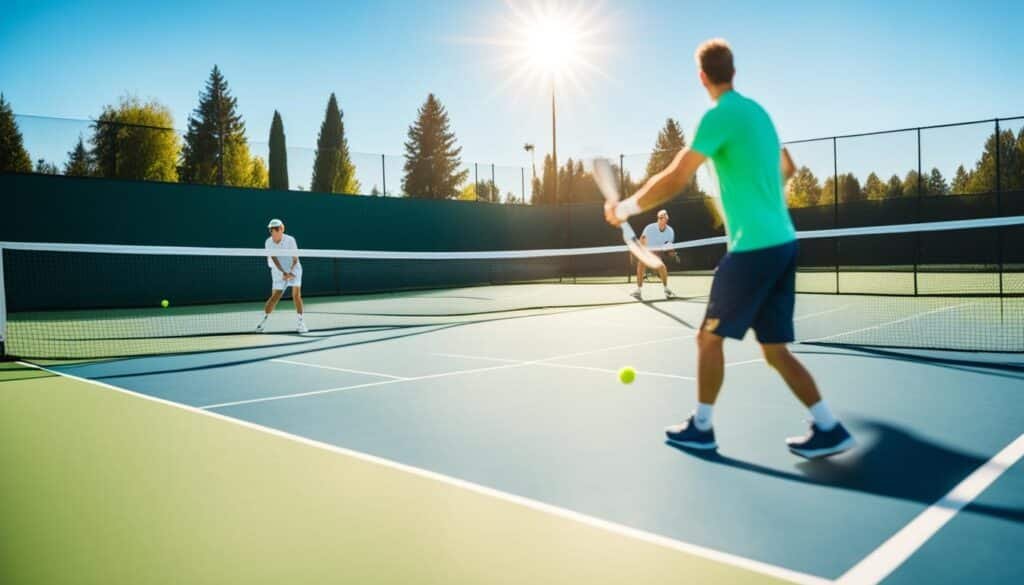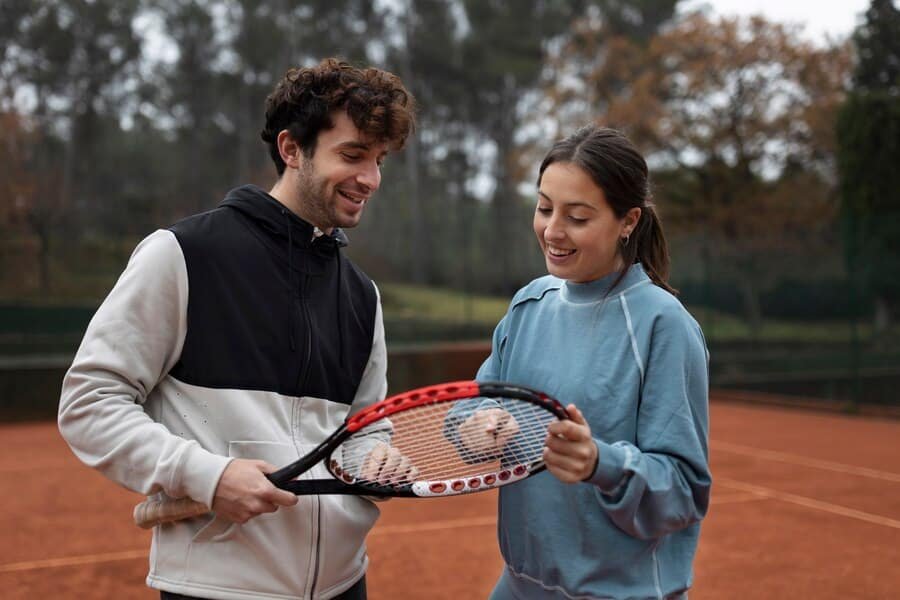Tennis For Beginners Whether you’re just starting out or you’re an experienced player, tennis is a sport that offers endless opportunities for growth and enjoyment. From the exhilarating rush of hitting a powerful forehand to the graceful finesse of a well-placed backhand, the game of tennis is a true testament to the beauty of athletic prowess. As a beginner, the path to mastering the fundamentals of tennis may seem daunting, but with the right guidance and a bit of practice, you’ll be on your way to becoming a confident and skilled player in no time.
Tennis drills for beginners are crucial to develop fundamental skills in the game of tennis. To start, beginners will need to focus on their serve, footwork, and overall court awareness. Learning the proper technique for serving is essential, as it sets the tone for each point. Beginners should practice tossing the ball and hitting it with their racquet to gain consistency and control. Footwork is another important aspect of the game, as it allows players to efficiently move around the court and set themselves up for successful shots.
One of the most important things for a beginner to focus on is developing a solid understanding of the basic tennis strokes, such as the forehand and backhand. These strokes form the foundation of your game, and with dedicated practice, you’ll be able to execute them with precision and control. Additionally, learning the proper swing technique, from the backswing to the follow-through, will help you generate more power and accuracy in your shots.
As you continue your tennis journey, it’s important to remember that the sport is a never-ending pursuit of improvement. Even the most experienced players are constantly working on refining their skills and discovering new ways to elevate their game. With a commitment to consistent practice, a willingness to learn, and a passion for the sport, you’ll be well on your way to mastering the basics of tennis and enjoying the countless benefits it has to offer.
Key Takeaways:
- Tennis drills for beginners are crucial to develop fundamental skills in the game of tennis.
- Focus on serving, footwork, and overall court awareness to build a solid foundation.
- Develop a strong understanding of the basic tennis strokes, such as the forehand and backhand.
- Learn proper swing technique to generate more power and accuracy in your shots.
- Commit to consistent practice and a willingness to learn to continuously improve your game.
Also Read :Fun Games To Play With Friends Indoors
Tennis Drills for Beginners
To start your tennis journey, it’s crucial to focus on developing your fundamental skills. This includes mastering your serve, footwork, and overall court awareness. Learning the proper technique for serving is essential, as it sets the tone for each point. Beginners should practice tossing the ball and hitting it with their racket to gain consistency and control.
Footwork Drills
Footwork is another important aspect of the game, as it allows players to efficiently move around the tennis court and set themselves up for successful shots. Incorporate footwork drills into your practice sessions to improve your agility and movement on the court.
Serving Drills
Mastering the tennis serve is a key skill for any beginner player. Practice tossing the ball and hitting it with proper form, focusing on consistency and control. This will help you develop a reliable first serve and gain an advantage over your opponents.
Forehand and Backhand Drills
In addition to serving, beginners should also dedicate time to honing their forehand and backhand strokes. Consistent practice with these fundamental shots will improve your overall game and help you become a well-rounded tennis player.
By focusing on these essential drills, beginner tennis players can develop the skills and confidence necessary to start enjoying the game and making progress on the court.
Also Read :From Courtside To Console: Exploring The Best Basketball Online Game
Essential Tennis Skills

Beginning tennis players need to start by mastering the basics. Hand-eye coordination is one of the most important foundations for success on the court. Players of any skill level should work on honing their coordination in order to gain an edge over the competition.
The Frying Pan Drill
New tennis players can practice their ball bouncing with the help of a racket. Have them hold the racket like a frying pan, then place a tennis ball on its face or strings. By slowly moving the racket up and down, the ball should start bouncing on its strings. Keep it bouncing as long as possible!
The Dribble Drill
Another great drill for improving hand-eye coordination is the dribble drill. Players stand on the court and gently toss the ball up, allowing it to bounce once before hitting it back up with their racket. The goal is to keep the ball bouncing and under control for as long as possible. This drill helps develop the essential ball-handling skills needed to become a well-rounded tennis player.
Also Read :Mastering The Court: Tips And Techniques For Winning Basketball Game
Volleys for Beginners

Beginner tennis players can use a volleying technique to put pressure on their opponent. Volleying involves using short ‘punch’ shots without much of a backswing. This is usually done close to the net, and can help put the other player on the defensive. To get the most out of your gear, practice volleying drills in your practice session. You’ll see your game improve and become more effective as a result.
| Volley Technique | Benefit for Beginners |
|---|---|
| Short, Punchy Shots | Puts opponent on the defensive |
| Minimal Backswing | Quicker reaction time and ball control |
| Close to the Net | Allows for aggressive, attacking play |
| Consistent Volley Drills | Improves overall game and effectiveness |
By mastering the volley, beginner tennis players can start to develop a well-rounded game that challenges their opponents and helps them improve their skills on the tennis court. With the right technique and regular practice, they’ll be on their way to becoming confident tennis players.
Also Read :How Do You Play Duckpin Bowling Baltimore?
Proper Swing Technique

Mastering the proper swing technique is essential for beginner tennis players looking to improve their game. By focusing on the fundamentals of swing mechanics, you can develop a powerful and consistent stroke that will serve you well on the court.
Low to High Swing Motion
When approaching the ball, it’s crucial to start your swing from a low position and finish high. Begin by turning your body to the side and drawing your racket back. Then, with a smooth, fluid motion, swing “low to high” as you make contact with the tennis ball. This low-to-high swing path not only generates more power, but also helps you impart the desired topspin on your shots.
Racket Face Positioning
In addition to the swing path, the orientation of your racket face is equally important. Ensure that the racket face is angled slightly open as you make contact with the ball. This will help you achieve a more controlled and consistent spin on your shots, making it harder for your opponent to return the ball effectively.
By mastering the low-to-high swing motion and proper racket face positioning, you’ll be well on your way to developing a sound, fundamental stroke technique that will serve you well on the tennis court. With practice and repetition, these techniques will become second nature, allowing you to play with confidence and precision.
Also Read :How To Play Cricket: A Beginner Guide For Americans
Tennis For Beginners

Tennis is a great way to have fun and stay active – so start today! Whether you’re a complete beginner or an experienced player, this versatile sport offers endless opportunities to improve your skills and enjoy the game. With the right guidance and practice, you’ll be able to develop a well-rounded tennis game that will serve you well on the court.
As a beginner, the key is to focus on mastering the fundamentals. This includes building a solid understanding of proper tennis strokes, footwork, and court positioning. With dedication and consistent practice, you’ll steadily progress and see your game evolve. Remember, every great tennis player started somewhere, so embrace the journey and have fun along the way.
To help get you started, consider taking tennis lessons from a qualified coach. They can provide personalized instruction and drills to accelerate your learning. You can also find beginner-friendly tennis clubs and group classes in your local area. With the right support and resources, you’ll be on your way to becoming a confident and capable tennis player in no time.
So why not give tennis a try today? It’s a fantastic way to stay active, meet new people, and challenge yourself both physically and mentally. Whether you’re looking to pick up a new hobby or take your game to the next level, the world of tennis has something for everyone. Embrace the sport, have fun, and see just how far your tennis journey can take you.
Mastering Forehand and Backhand
Tennis players need a strong forehand and backhand to succeed. Developing each of these strokes takes practice and dedication. To master the fundamentals, focus on every part of the movement – from the backswing to the point of contact to the follow-through. With enough time on the court, each stroke will get stronger and become more accurate, giving you the tools to dominate your opponents.
Forehand Technique
The forehand is often considered the most natural and powerful stroke in tennis. To execute a proper forehand, start by gripping the racket firmly in your dominant hand. As you approach the ball, turn your body to the side and bring the racket back in a smooth, controlled backswing. Keep your eyes on the ball and make contact in front of your body, driving through the shot with a low-to-high swing motion. Follow through by continuing the racket head across your body, maintaining balance and control.
Backhand Technique
The backhand can be a bit trickier, but with the right technique, it can be just as effective as the forehand. Stand side-on to the net, with your non-dominant foot slightly ahead. Grip the racket with a continental or semi-western grip, then bring the racket back in a compact backswing. As you make contact, rotate your hips and shoulders to generate power, keeping your eyes on the ball. Finish the stroke by following through across your body.
Consistent practice of both the forehand and backhand will help you develop a well-rounded game. Whether you’re a beginner or an advanced player, mastering these fundamental strokes is the key to success on the tennis court.
Hit and Catch Drill

Players stand on the center service line, ready to receive a forehand. An instructor stands nearby, holding a cone and some tennis balls. With this drill, the instructor’s goal is to help players get comfortable on the court and start building their tennis skills.
Directional Hitting
Players work on their timing and accuracy as they hit and catch balls thrown by the instructor using the cone. The drill encourages players to focus on directional hitting, helping them develop the ability to consistently strike the ball in the intended direction.
Hand-Eye Coordination
By continuously hitting and catching the balls, players improve their hand-eye coordination, a fundamental aspect of the game. This drill allows beginners to become more familiar with the feel of the racket and the timing required to make solid contact with the ball.
As their confidence grows, more advanced drills can be introduced for further skill development. This hit and catch drill serves as a great starting point for new tennis players, helping them lay the foundation for mastering the game.
Tennis Court Fundamentals
Mastering the intricacies of the tennis court is akin to navigating the landscape of life itself. Understanding the court’s intricate geography unveils a realm of strategic possibilities, transforming your on-court experience. From the precise lines delineating the playing area to the net that divides the court, each element holds the potential to elevate your game.
Court Lines and Areas
The tennis court is a canvas of intersecting lines, each with a distinct purpose. The service lines, baselines, and sidelines define the boundaries of the court, while the center service line divides the court into halves. The service boxes, located at either end of the court, are critical areas for serving and strategic positioning. Familiarizing yourself with these court lines and areas will empower you to make informed decisions and execute your shots with precision.
Understanding the Net
The net, standing tall at the center of the court, is more than just a physical barrier. It serves as a visual cue, guiding your shot selection and strategy. Recognizing the net’s height and the space underneath it can help you anticipate your opponent’s shots and determine the optimal approach for your own. Whether you’re volleying at the net or engaging in baseline rallies, a thorough understanding of the net’s role in the game will give you a competitive edge.
Cross-Court vs. Down the Line Shots
The court’s layout offers two primary shot directions: cross-court and down the line. Cross-court shots travel diagonally across the court, while down the line shots travel parallel to the sidelines. Mastering both types of shots is essential, as they present different challenges and opportunities. Understanding the advantages of each shot type, such as the increased court coverage of a cross-court shot or the power and precision of a down the line shot, will allow you to make informed decisions and outmaneuver your opponents.
Also Read: Mastering The Court: Tips And Techniques For Winning Basketball Game
Conclusion
“Mastering The Basics: Tennis For Beginners” provides an invaluable resource for those new to the sport, laying a solid foundation for future improvement and enjoyment. This guide systematically covers the essential elements of tennis, from understanding the rules and scoring system to mastering fundamental techniques like the serve, forehand, backhand, and volley. By breaking down these basics into manageable steps, it ensures that beginners can gradually build their skills and confidence on the court.
Emphasizing the importance of proper grip, stance, and footwork, the guide helps newcomers develop good habits early on, which are crucial for long-term success. Additionally, it highlights the significance of mental preparation and strategic thinking, encouraging beginners to not only focus on physical skills but also on game strategy and psychological resilience.
The guide also underscores the value of consistent practice and patience, reminding beginners that progress in tennis, as in any sport, requires time and dedication. Practical tips on selecting appropriate equipment and finding suitable practice partners or groups further enhance the learning experience.
Ultimately, “Mastering The Basics: Tennis For Beginners” empowers new players with the knowledge and skills they need to enjoy the game and sets them on a path toward becoming proficient tennis players, ready to take on more advanced challenges and enjoy the lifelong benefits of this dynamic and rewarding sport.
FAQs
Q: What is tennis?
A: Tennis is a sport played by two or four players hitting a small ball back and forth across a net using a racket. The objective is to score points by making the ball land in the opponent’s court.
Q: How can I start playing tennis as a beginner?
A: To start playing tennis as a beginner, you can consider taking tennis lessons from a qualified tennis coach. Learning the basics, such as proper grip, footwork, and swing technique, will help you get started on the right foot.
Q: What are some tips for beginners looking to improve their tennis game?
A: Some tips for beginners include practicing regularly, focusing on footwork, mastering basic strokes like forehand and backhand, and playing with a purpose to improve your skills. It’s also important to stay patient and consistent in your training.
Q: How do I choose the right tennis racket?
A: When choosing a tennis racket, consider factors such as your playing style, grip size, weight, and head size. It’s recommended to test different rackets to find the one that feels comfortable and suits your playing level.
Q: What is a double in tennis?
A: In tennis, a double is the term used to describe a fault in serving where the server fails to get the ball in the service box on both the first and second attempts.
Q: What is a drop shot in tennis?
A: A drop shot is a tennis shot that is hit softly and close to the net, causing the ball to drop suddenly and bounce low, making it difficult for the opponent to reach and return the ball.
Q: How can cross-training help improve my tennis game?
A: Cross-training, such as incorporating activities like running, swimming, or strength training, can help improve your overall fitness, endurance, and agility, which are important aspects of excelling in tennis.
Source Links
- https://www.indietenis.com/indie-tenis-blog/how-to-play-tennis-better-powerful-tennis-tips-for-beginners
- https://www.pop-tennis.org/post/basic-tennis-skills-for-beginners
- http://tt.tennis-warehouse.com/index.php?threads/best-order-to-learn-fundamentals.685055/





